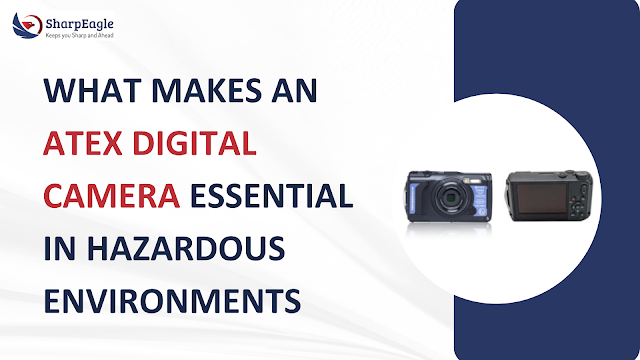Common Mistakes to Avoid When Using Explosion Proof Digital Cameras
Explosion proof digital cameras are essential tools in hazardous environments such as oil and gas plants, chemical factories, mining sites, and other potentially explosive atmospheres. These rugged devices are specifically engineered to prevent internal sparks or heat from triggering fires or explosions in volatile areas.
However, despite their durability and safety certifications, ATEX digital cameras can still be compromised if not handled or used correctly. Improper use can lead to performance issues, safety risks, and even non-compliance with regulatory standards.
To help you get the most out of your investment and ensure workplace safety, here are common mistakes to avoid when using explosion proof digital cameras:
1. Using Certified Cameras in Hazardous Zones
One of the biggest and most dangerous mistakes is using regular or non-certified cameras in ATEX, IECEx, or Class I Div 1 environments. These areas contain flammable gases, vapors, or dust that can ignite from even the smallest spark.
Solution: Always check for certifications like ATEX, IECEx, or UL to ensure the camera is suitable for your zone classification. A camera without proper certification may not have the necessary safety features to operate in explosive atmospheres.
2. Ignoring Maintenance and Inspection Schedules
Explosion proof cameras, like any other equipment in harsh environments, require routine inspection and maintenance. Ignoring wear and tear or environmental buildup can result in component failure.
Solution: Schedule regular inspections to clean lenses, check seals and connectors, and verify enclosure integrity. Preventive maintenance helps extend the lifespan and reliability of your device.
3. Modifying the Camera Hardware
Some users try to open, modify, or customize the explosion proof camera housing to add features or make adjustments. This can violate its certification and create dangerous vulnerabilities.
Solution: Never attempt to alter or open the housing of an explosion proof camera. Doing so can invalidate its safety certifications and expose the internal components to explosive environments. Use only manufacturer-approved accessories and upgrades.
4. Inadequate Training of Personnel
Even the best equipment can fail if the operator does not understand its functionality or safety requirements. Untrained personnel may mishandle the device, miss warning signs, or misuse the features.
Solution: Provide proper training on handling, operating, and maintaining explosion proof cameras. Ensure operators understand how the camera works and what precautions must be taken when using it in high-risk environments.
5. Using the Wrong Power Source or Cabling
Not all power sources are suitable for hazardous areas. Using incompatible power supplies or running standard cables in an explosive zone can create serious risks.
Solution: Always use explosion proof rated power supplies, connectors, and cables. Make sure the camera system’s power source matches the specifications outlined by the manufacturer.
6. Overlooking Environmental Factors
Hazardous zones may also present challenges like extreme temperatures, moisture, dust, or corrosive gases. Even explosion proof cameras can degrade if environmental limits are exceeded.
Solution: Choose a camera model that is rated for your specific environmental conditions. Monitor the surrounding temperature, humidity, and exposure levels, and use protective accessories like sunshields or corrosion-resistant coatings if necessary.
7. Neglecting Firmware and Software Updates
Just like any modern digital device, explosion proof cameras often come with firmware or software that controls performance. Failing to update them can result in reduced functionality or even security risks.
Solution: Stay up to date with firmware or software patches from the manufacturer. These updates can improve performance, fix bugs, and enhance compatibility with video management systems.
8. Improper Data Management and Storage
If video footage and images are not properly stored, you risk losing critical evidence or documentation. This is especially important in environments where cameras are used for inspections, compliance, or incident tracking.
Solution: Ensure proper backup systems and data transfer processes are in place. Use secure, rugged storage devices or cloud platforms approved for industrial use.
9. Failing to Replace Aging Equipment
Explosion proof cameras are built to last, but like any equipment, they have a lifecycle. Continuing to use an outdated or damaged camera can compromise image quality and safety.
Solution: Monitor the performance and physical condition of your cameras over time. Replace aging units or accessories that no longer meet operational or safety standards.
Final Thoughts
Explosion proof digital cameras are invaluable assets for industrial safety, inspection, and documentation in high-risk environments. But to harness their full potential, it’s crucial to avoid common usage mistakes. Prioritizing proper installation, regular maintenance, operator training, and certified equipment will not only protect your investment but also safeguard your people and property.
By staying informed and proactive, your team can ensure both compliance and performance when using explosion proof digital cameras in the most demanding environments.
Need Help Choosing the Right Explosion Proof Camera?
At SharpEagle Technology, we provide certified explosion proof digital cameras designed for various industrial applications. Our expert team can help you select, install, and maintain the right solution for your hazardous zone.
Visit www.sharpeagle.uk to explore our product range or get in touch with our safety specialists today!




Comments
Post a Comment